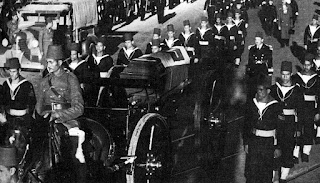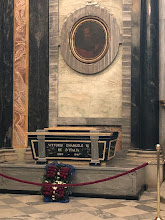Match-fixing scheme saw players banned and clubs relegated
 |
| The front page of the sports daily Gazzetta dello Sport, reporting "handcuffs in the stadiums" |
Two Serie A clubs - AC Milan and Lazio - were relegated to Serie B. Three others in Serie A and two in Serie B were handed a penalty in the form of a five-point deduction in their respective league tables.
Of 20 players banned, some indefinitely, by the Italian Football Federation (FIGC), half had represented the Italy national team. The most famous were Paolo Rossi, who would go on to be part of the Azzurri team that won the World Cup in Spain in 1982, and Enrico Albertosi, who had been goalkeeper in the Italian team that won the European championships in 1968.
Rossi, who scored six goals in Spain ‘82, would have missed the tournament had his sentence not been reduced, somewhat controversially, from three years to two.
Felice Colombo, then president of AC Milan, was banned from football for life, although the disqualification was later reduced to six years.
The scandal came about at a time when a state-run competition known as Totocalcio, similar to the football pools that were popular in Britain, was the only legal form of football betting in Italy.
To win, participants needed to correctly predict the outcome of 12 games, which was realistically too many for the competition to be fixed. However, bets on individual matches could be wagered with illegal bookmakers.
.jpg) |
| Paolo Rossi in the red Perugia, for whom he was playing when the scandal broke |
It was the existence of this football betting black market that persuaded a struggling Rome fruit and vegetable merchant, Massimo Cruciani, to approach one of his customers, restaurant owner Alvaro Trinca, with his idea for a match-fixing scheme.
Cruciani knew that Trinca’s La Lampara restaurant, near Piazza del Popolo in the centre of Rome, was popular with players from both AS Roma and their city rivals, Lazio.
The betting black market, known colloquially as totonero, was huge, worth billions of lire in turnover, so the potential was there to win large amounts of money. Cruciani and Trinca had no problem recruiting willing participants in their scheme, promising generous payments.
Milan president Colombo was on board at the start and with the help of two Milan players - Albertosi and Giorgio Marini - plus four from Lazio - Bruno Giordano, Lionello Manfredonia, Massimo Cacciatori and Giuseppe ‘Pino’ Wilson - the syndicate successfully fixed a Serie A match between the clubs on 6 January, 1980, which finished in a 2-1 win for Milan. It is said that they each received a share of some 20 million lire collected in winnings.
Yet subsequent matches did not go as planned, with Cruciani and Trinca soon suffering heavy losses. Facing bankruptcy, they took the bizarre decision to file a complaint with the Public Prosecutor's Office in Rome.
Despite the illegal nature of what they had been doing, they claimed they had been defrauded. On 1 March, 1980, they handed over the names of 27 players and 12 Serie A and B clubs that they alleged were involved.
Within a week, Trinca himself had been arrested, Cruciani turning himself in a few days later. Rumours of player involvement in match rigging began to circulate. Then, on Sunday, 23 March - a match day - officers from the Guardia di Finanza - Italy’s fraud squad - simultaneously carried out dramatic raids at a number of stadiums.
 |
| Defendants in the first criminal trial of those accused in the scandal. Paolo Rossi is second from the right. |
The drama at the Stadio Olimpico in Rome was shown live on Rai Uno’s 90º minuto (90th Minute) football results show as a police car appeared on the perimeter running track shortly before the referee blew for time, officers emerging to arrest Perugia’s Mauro Della Martira and Luciano Zecchini.
In all, 14 players were detained, along with Colombo of Milan. They were taken to Rome’s Regina Coeli prison, where they were held on charges of complicity in aggravated and continued fraud.
Rossi, then a Perugia player, was not among those held initially, but received a summons a few days later. The striker, who died in 2020 at the age of just 64m, always protested his innocence.
Despite the long legal process that followed, all of those arrested were ultimately acquitted of criminal charges, largely because fraud could not be proved and no laws existed in Italy at the time that applied to rigging sporting events.
Nonetheless, there was nothing to prevent the governing body of a sport imposing sanctions of their own. As soon as the legal proceedings had been concluded, the Italian Football Federation wasted no time in announcing their own response.
Although there have been a number of betting scandals in Italian football since Totonero, at the time it was unprecedented and the repercussions were such that it cast a dark shadow over football in Italy.
Travel tip:.jpg)
The circular layout of Piazza del Popolo is similar
to that of Bernini's plan for St Peter's Square
Rome’s Piazza del Popolo can be found at the end of the Via del Corso, the long, straight thoroughfare stretching north from Piazza Venezia. The name of the square is often taken to mean the square “of the people”. In fact, many people believe Popolo derives from the Latin populus – poplar – after the trees from which the church of Santa Maria del Popolo is named. The piazza as it looks today was redesigned in neoclassical style between 1811 and 1822 by the architect Giuseppe Valadier, his circular layout reminiscent of Bernini's plan for St. Peter's Square. At the centre is an Egyptian obelisk, one of the tallest in Rome at 24m (79ft) - 36m (118ft) including the plinth - that was moved to the original square from the Circus Maximus in 1589.
Travel tip:
Rome's Stadio Olimpico, as it would have looked
in 1980, before it was rebuilt for Italia '90
Rome's Stadio Olimpico, where part of the drama of Totonero unfolded on live television, was built between 1928 and 1938 as part of the Foro Mussolini (now Foro Italico), a sports complex Benito Mussolini hoped would enable Rome to host the 1944 Olympics had they taken place. Originally named Stadio dei Cipressi and later Stadio dei Centomila, it was renamed when Rome won the bidding process for the 1960 Games, pipping the Swiss city of Lausanne. Rebuilt for the 1990 football World Cup, it is now home to the Roma and Lazio football clubs and has hosted four European Cup/Champions League finals.
Also on this day:
1554: The death of painter Alessandro Bonvicino
1821: The birth of musician Giovanni Bottesini
1858: The birth of opera composer Giacomo Puccini
1908: The birth of sculptor Giacomo Manzù
1963: The birth of footballer Giuseppe Bergomi



_cropped.jpg)
.jpg)


.jpg)




.jpg)


.jpg)

.jpg)

.jpg)








